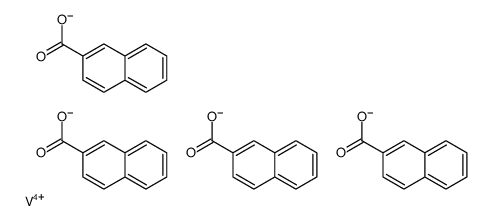68553-60-6
| 中文名 | 环烷酸氧化钒 |
|---|---|
| 英文名 | Vanadium Naphthenate Oxide in Naphthenic Acid |
| 中文别名 | 萘酸氧化钒 |
| 英文别名 |
EINECS 271-395-7
MFCD00148763 naphthalene-2-carboxylate,vanadium(4+) |
| 密度 | 1.04 g/cm3 |
|---|---|
| 分子式 | C44H28O8V |
| 分子量 | 735.63000 |
| 闪点 | 30ºC |
| 精确质量 | 735.12200 |
| PSA | 160.52000 |
| LogP | 4.81320 |
| 外观性状 | 绿色油性液体 |
| 储存条件 | 存放在密封容器内,并放在阴凉,干燥处。储存的地方必须上锁,钥匙必须交给技术专家和他们的助手保管。储存的地方必须远离氧化剂。 |
| 稳定性 | 远离氧化物。 |
| 水溶解性 | Insoluble in water. |
| 计算化学 | 1.疏水参数计算参考值(XlogP):无 2.氢键供体数量:0 3.氢键受体数量:8 4.可旋转化学键数量:0 5.互变异构体数量:无 6.拓扑分子极性表面积161 7.重原子数量:53 8.表面电荷:0 9.复杂度:195 10.同位素原子数量:0 11.确定原子立构中心数量:0 12.不确定原子立构中心数量:0 13.确定化学键立构中心数量:0 14.不确定化学键立构中心数量:0 15.共价键单元数量:5 |
| 更多 | 1. 性状:黑色液体。 2. 密度(g/mL,25/4℃):1.04 3. 相对蒸汽密度(g/mL,空气=1):未确定 4. 熔点(ºC):未确定 5. 沸点(ºC,常压):未确定 6. 沸点(ºC,5.2kPa):未确定 7. 折射率:未确定 8. 闪点(ºC):未确定 9. 比旋光度(º):未确定 10. 自燃点或引燃温度(ºC):>350 11. 蒸气压(kPa,25ºC):未确定 12. 饱和蒸气压(kPa,60ºC):未确定 13. 燃烧热(KJ/mol):未确定 14. 临界温度(ºC):未确定 15. 临界压力(KPa):未确定 16. 油水(辛醇/水)分配系数的对数值:未确定 17. 爆炸上限(%,V/V):未确定 18. 爆炸下限(%,V/V):未确定 19. 溶解性:不能溶于水。 |
|
Section 1: Product Identification Chemical Name:Vanadyl naphthenate, 35% in naphthenic acid (2.8-3.2% V) CAS Registry Number:68553-60-6 Formula:Vanadyl salt of napthenic acid EINECS Number:none Chemical Family:metal carboxylate Synonym:Naphthenic acid, vanadium salt, in alkylated cycloalkane carboxylic acids.
Section 2: Composition and Information on Ingredients IngredientCAS NumberPercentACGIH (TWA)OSHA (PEL) Title Compound68553-60-635%no datano data naphthenic acid1338-24-565%no datano data Section 3: Hazards Identification Emergency Overview:Severely irritating to eyes, skin and respiratory tract. May be harmful if swallowed. Primary Routes of Exposure:Ingestion, eyes, inhalation, skin Eye Contact:Causes severe irritation to the eyes. Skin Contact:Causes moderate to severe irritation of the skin. Inhalation:Vapor will severely irritate the nose, mucous membranes and respiratory tract. Ingestion:Ingestion may cause gastrointestinal distress, nausea, dizziness, weakness. Acute Health Affects:Irritating to skin, eyes and respiratory tract. Chronic Health Affects:No information available on long-term chronic effects. NTP:No IARC:No OSHA:No SECTION 4: First Aid Measures Immediately flush the eyes with copious amounts of water for at least 10-15 minutes. A victim may need Eye Exposure: assistance in keeping their eye lids open. Get immediate medical attention. Wash the affected area with soap and water. Remove contaminated clothes if necessary. Seek medical Skin Exposure: assistance if irritation persists. Remove the victim to fresh air. Closely monitor the victim for signs of respiratory problems, such as difficulty Inhalation: in breathing, coughing, wheezing, or pain. In such cases seek immediate medical assistance. Ingestion:Seek medical attention immediately. Keep the victim calm. Give the victim water (only if conscious). SECTION 5: Fire Fighting Measures Flash Point:>350 °F Autoignition Temperature:no data Explosion Limits:none Extinguishing Medium:carbon dioxide, dry powder or foam If involved in a fire, fire fighters should be equipped with a NIOSH approved positive pressure self-contained Special Fire Fighting Procedures: breathing apparatus and full protective clothing. Hazardous Combustion andIf involved in a fire this material may emit toxic organic fumes. Decomposion Products: Unusual Fire or Explosion Hazards: No unusual fire or explosion hazards. SECTION 6: Accidental Release Measures Eliminate all ignition sources. Small spills may be adsorbed into diatomaceous earth, sand, or other suitable Spill and Leak Procedures: adsorbent, and swept up. SECTION 7: Handling and Storage Handling and Storage:Store in a sealed container. Keep away from heat and moisture. SECTION 8: Exposure Controls and Personal Protection Eye Protection:Always wear approved safety glasses when handling a chemical substance in the laboratory. Skin Protection:Wear appropriate chemical resistant gloves and protective clothing. Ventilation:Material may form a vapor. If possible, handle the material in an efficient fume hood. If ventilation is not available a respirator should be worn. The use of respirators requires a Respirator Respirator: Protection Program to be in compliance with 29 CFR 1910.134. Ventilation:Material may form a vapor. If possible, handle the material in an efficient fume hood. Additional Protection:No additional protection required. SECTION 9: Physical and Chemical Properties Color and Form:viscous liq. Molecular Weight:not applicable Melting Point:no data Boiling Point:no data Vapor Pressure:no data Specific Gravity:1.04 Odor:organic odor Solubility in Water:insoluble SECTION 10: Stability and Reactivity Stability:air and moisture stable liquid Hazardous Polymerization:no hazardous polymerization Conditions to Avoid:none Incompatibility:oxidizing agents, bases Decomposition Products:Carbon dioxide, carbon monoxide, organic vapors, and metal oxides and carbonates. SECTION 11: Toxicological Information RTECS Data:No information available in the RTECS files for title compound. Naphthenic acid: Oral (rat) LD50: 3g/Kg; Carcinogenic Effects:none Mutagenic Effects:none Tetratogenic Effects:none SECTION 12: Ecological Information Ecological Information:No information available SECTION 13: Disposal Considerations Disposal:Dispose of according to local, state and federal regulations. SECTION 14: Transportation Shipping Name (CFR):Non-hazardous Hazard Class (CFR):NA Additional Hazard Class (CFR):NA Packaging Group (CFR):NA UN ID Number (CFR):NA Shipping Name (IATA):Non-hazardous Hazard Class (IATA):NA Additional Hazard Class (IATA):NA Packaging Group (IATA):NA UN ID Number (IATA):NA SECTION 15: Regulatory Information TSCA:Listed in the TSCA inventory. SARA (Title 313):Title compound not listed. Second Ingredient:Not listed in the TSCA inventory SECTION 16 - ADDITIONAL INFORMATION N/A |
|
生态学数据: 对水稍微有危害的,不要让未稀释或者大量产品接触地下水,水道或者污水系统。若无政府许可,勿将材料排入周围环境。
|
| 风险声明 (欧洲) | R36/37/38 |
|---|---|
| 安全声明 (欧洲) | S26-S36-S37-S39 |
| 危险品运输编码 | UN 3285 6.1/PG 3 |
| 包装等级 | III |
| 危险类别 | 6.1 |


